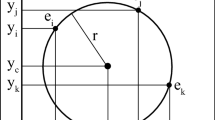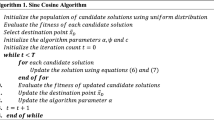Abstract
This article presents an algorithm for the automatic detection of circular shapes from complicated and noisy images without using the conventional Hough transform methods. The proposed algorithm is based on a recently developed swarm intelligence technique, known as the bacterial foraging optimization (BFO). A new objective function has been derived to measure the resemblance of a candidate circle with an actual circle on the edge map of a given image based on the difference of their center locations and radii lengths. Guided by the values of this objective function (smaller means better), a set of encoded candidate circles are evolved using the BFO algorithm so that they can fit to the actual circles on the edge map of the image. The proposed method is able to detect single or multiple circles from a digital image through one shot of optimization. Simulation results over several synthetic as well as natural images with varying range of complexity validate the efficacy of the proposed technique in terms of its final accuracy, speed, and robustness.





Similar content being viewed by others
References
Abraham A, Guo H, Liu H (2006) Swarm intelligence: foundations, perspectives and applications, swarm intelligent systems. In: Nedjah N, Mourelle L (eds) Studies in computational intelligence. Springer, Germany, pp 3–25
Anwal RP (1998) Generalized functions: theory and technique, 2nd edn. Birkhãuser, Boston
Ayala-Ramirez V, Garcia-Capulin CH, Perez-Garcia A, Sanchez-Yanez RE (2006) Circle detection on images using genetic algorithms. Pattern Recogn Lett 27:652–657
Becker J, Grousson S, Coltuc D (2002) From Hough transforms to integral transforms. In: Proceedings of international geoscience and remote sensing symposium, IGARSS_02 3:1444–1446
Biswas A, Dasgupta S, Das S, Abraham A (2007) A synergy of differential evolution and bacterial foraging algorithm for global optimization. Neural Netw World 17(6):607–626
Bongiovanni G, Crescenzi P (1995) Parallel simulated annealing for shape detection. Comput Vision Image Understanding 61(1):60–69
Canny J (1986) A computational approach to edge detection. IEEE Trans Pattern Anal Mach Intell 8:679–714
Das S, Biswas A, Dasgupta S, Abraham A (2009a) Bacterial foraging optimization algorithm: theoretical foundations, analysis, and applications, foundations of computational intelligence. Global optimization, studies in computational intelligence, vol 3. Springer, Germany, pp 23–55. ISBN: 978-3-642-01084-2
Das S, Dasgupta S, Biswas A, Abraham A, Konar A (2009b) On stability of the chemotactic dynamics in bacterial foraging optimization algorithm. IEEE Trans Syst Man Cybern Part A 39(3):670–679
Dasgupta S, Das S, Abraham A, Biswas A (2009) Adaptive computational chemotaxis in bacterial foraging optimization: an analysis. IEEE Trans Evol Comput 13(4):919–941
De-Sian L, Chien-Chang C (2008) Edge detection improvement by ant colony optimization. Pattern Recogn Lett 29(4):416–425
Dorigo M, Gambardella LM (1997) Ant colony system: a cooperative learning approach to the traveling salesman problem. IEEE Trans Evol Comput 1(1):53–66
Duda RO, Hart PE (1972) Use of the Hough transformation to detect lines and curves in pictures. Comm Assoc Comput Mach 15:11–15
Fischer M, Bolles R (1981) Random sample consensus: a paradigm to model fitting with applications to image analysis and automated cartography. CACM 24(6):381–395
Fletcher R (1987) Practical methods of optimization, 2nd edn. Wiley, Chichester
García S, Molina D, Lozano M, Herrera F (2008) A study on the use of non-parametric tests for analyzing the evolutionary algorithms’ behaviour: a case study on the CEC’2005 Special session on real parameter optimization. J Heurist. doi:10.1007/s10732-008-9080-4
Goldberg DE (1989) Genetic algorithms in search. Optimization and machine learning. Kluwer, Boston
Han JH, Koczy LT, Poston T (1993) Fuzzy Hough transform. In: Proceedings 2nd international conference on fuzzy systems 2:803–808
Illingworth J, Kittler J (1988) Survey: a survey of the Hough transform. Comput Vision Graphics Image Process 44:87–116
Kelly M, Levine M (1997) Advances in image understanding. Finding and describing objects in complex images. IEEE Computer Society Press, pp 209–225
Kennedy J, Eberhart R, Shi Y (2001) Swarm intelligence. Morgan Kaufmann Academic Press, Menlo Park
Kim DH, Abraham A, Cho JH (2007) Hybrid genetic algorithm and bacterial foraging approach for global optimization. Inf Sci 177(18):3918–3937
Lam W, Yuen S (1996) Efficient techniques for circle detection using hypothesis filtering and Hough transform. IEEE Proc Visual Image Signal Process 143(5):292–300
Le Hégarat-Mascle S, Hégarat-Mascle L, Kallel A, Descombes X (2007) Ant colony optimization for image regularization based on a nonstationary markov modeling. IEEE Trans Image Process 16(3):865–878
Leavers VF (1993) Survey: which Hough transforms. CVGIP Image Understanding 58:250–264
Liu Y, Passino KM (2002) Biomimicry of social foraging bacteria for distributed optimization: models, principles, and emergent behaviors. J Optim Theory Appl 115(3):603–628
Liu H, Abraham A, Clerc M (2007a) Chaotic dynamic characteristics in swarm intelligence. Appl Soft Comput J 7(3):1019–1026
Liu H, Abraham A, Zhang W (2007b) A fuzzy adaptive turbulent particle swarm optimization. Int J Innov Comput Appl 1(1):39–47
Lutton E, Martinez P (1994) A genetic algorithm for the detection 2-D geometric primitives on images. In: Proceedings of the 12th international conference on pattern recognition (ICPR_94), vol 1, Jerusalem, Israel, pp 526–528
Mishra S (2005) A hybrid least square-fuzzy bacterial foraging strategy for harmonic estimation. IEEE Trans Evol Comput 9(1):61–73
Mishra S, Bhende CN (2007) Bacterial Foraging Technique-Based Optimized Active Power Filter for Load Compensation. IEEE Trans Power Deliv 22(1):457–465
Ong YS, Keane AJ (2004) Meta-Lamarckian learning in memetic algorithms. IEEE Trans Evol Comput 8:99–110
Passino KM (2002) Biomimicry of bacterial foraging for distributed optimization and control. IEEE Control Systems Magazine, pp 52–67
Roth G, Levine MD (1994) Geometric primitive extraction using a genetic algorithm. IEEE Trans Pattern Anal Mach Intell 16(9):901–905
Santamaría J, Cordón O, Damas S, García-Torres JM, Quirin A (2009) Performance evaluation of memetic approaches in 3D reconstruction of forensic objects. Soft Comput 13(8–9):883–904
Shaked D, Yaron O, Kiryati N (1996) Deriving stopping rules for the probabilistic Hough transform by sequential analysis. Computer Vision Image Understanding 63:512–526
Tripathy M, Mishra S, Lai LL, Zhang QP (2006) Transmission loss reduction based on FACTS and bacteria foraging algorithm. PPSN, pp 222–231
Wachowiak MP, Smolikova R, Yufeng Z, Zurada JM, Elmaghraby AS (2004) An approach to multimodal biomedical image registration utilizing particle swarm optimization. IEEE Trans Evol Comput 8(3):289–301
Wilcoxon F (1945) Individual comparisons by ranking methods. Biometrics 1:80–83
Xu L, Oja E, Kultanen P (1990) A new curve detection method: Randomized Hough Transform (RHT). Pattern Recogn Lett 11(5):331–338
Yao J, Kharma N, Grogono P (2004) Fast robust GA-based ellipse detection. In: Proceedings of 17th international conference on pattern recognition ICPR-04, vol 2, Cambridge, UK, pp 859–862
Author information
Authors and Affiliations
Corresponding author
Rights and permissions
About this article
Cite this article
Dasgupta, S., Das, S., Biswas, A. et al. Automatic circle detection on digital images with an adaptive bacterial foraging algorithm. Soft Comput 14, 1151–1164 (2010). https://doi.org/10.1007/s00500-009-0508-z
Published:
Issue Date:
DOI: https://doi.org/10.1007/s00500-009-0508-z




